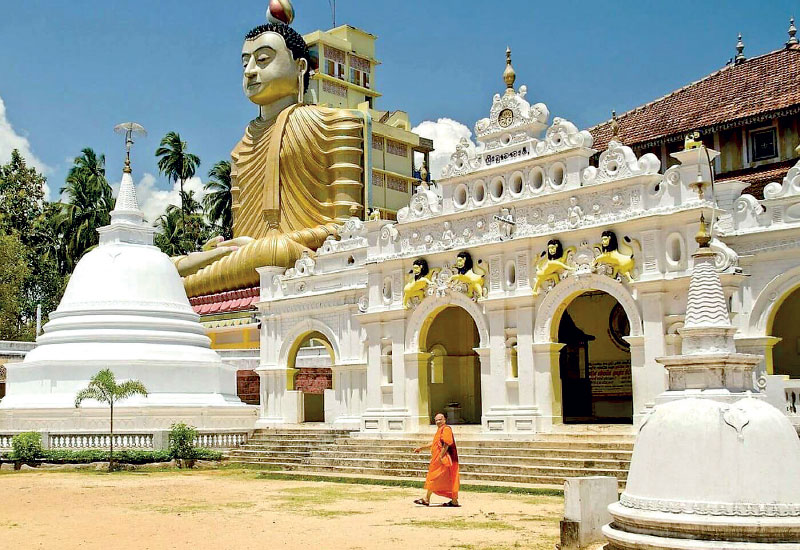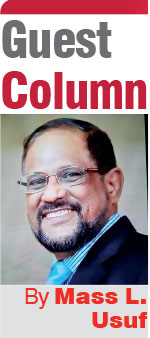Saturday Dec 27, 2025
Saturday Dec 27, 2025
Thursday, 30 October 2025 00:19 - - {{hitsCtrl.values.hits}}

Under the guise of cultural preservation, pre-eminence is given to Buddhism, claiming that Sri Lanka is the sacred land of Buddhism and that it belongs to the Sinhalese race only
 To effectively address the deep-rooted issue of racism in Sri Lanka, the Government should establish a representative independent body composed of intellectuals, academics, religious dignitaries, and civil society representatives. This body must be legally mandated to investigate the origins, evolution, and persistence of racism, particularly in relation to politics, religion, and the role of monks and temples. It can benefit from the multitudes of research materials. It should also examine how certain factors from ethnic and religious minorities may unintentionally contribute to racism
To effectively address the deep-rooted issue of racism in Sri Lanka, the Government should establish a representative independent body composed of intellectuals, academics, religious dignitaries, and civil society representatives. This body must be legally mandated to investigate the origins, evolution, and persistence of racism, particularly in relation to politics, religion, and the role of monks and temples. It can benefit from the multitudes of research materials. It should also examine how certain factors from ethnic and religious minorities may unintentionally contribute to racism
“Sinhalese Buddhism has made no significant contribution to the evolution of a non-violent social ideology” – Jayadeva Uyangoda
 Just like evergreen songs – Sinhala Buddhist nationalism and racism are live topics anytime in this land of compassion. These sentiments are characterised by blind impulsive reactions driven by emotions and prejudice, rather than by caution, rationality and objectivity. Additionally, serve as a convenient whip in the hands of politicians, racists and other several types of opportunists. Circumstances may be aggravated when the saffron clad elite who share such characteristics takes the lead. Buddha, the Dhamma and especially, the Kalama Sutta which encourages critical thinking and rejection of blind following comes to mind with profound sadness.
Just like evergreen songs – Sinhala Buddhist nationalism and racism are live topics anytime in this land of compassion. These sentiments are characterised by blind impulsive reactions driven by emotions and prejudice, rather than by caution, rationality and objectivity. Additionally, serve as a convenient whip in the hands of politicians, racists and other several types of opportunists. Circumstances may be aggravated when the saffron clad elite who share such characteristics takes the lead. Buddha, the Dhamma and especially, the Kalama Sutta which encourages critical thinking and rejection of blind following comes to mind with profound sadness.
Equating Buddhism to a race
In Delict law, fraudulent misrepresentation involves knowingly or recklessly making a false statement that misleads another person, who relies on it in decision-making, resulting in economic loss due to the deception.
Not direct, but to draw a close analogy, matters relating to Buddhism, religion, ethnicities, nationalism are presented in a confused format to the Sinhala people by some of the monks, especially to the rural folks. In Buddhist culture a monk is highly revered and the people rely on them. A monk is a formidable “influencer” on the minds of the Buddhist population. Some of these monks, use this position to purposely inculcate divisive thoughts in the minds of the innocent Sinhala population as has been publicly known. It may be for political advantage, opportunity to self-enrich or pure racism.
On observation, it seems that under the guise of cultural preservation, pre-eminence is given to Buddhism, claiming that Sri Lanka is the sacred land of Buddhism and that it belongs to the Sinhalese race only. Thus, they have the prime responsibility of protecting Buddhism and this sacred land.
Of course, the learned Elders of Buddhism would say that this notion is far away from the Dhamma. After all, ‘Siyalu sathwayo niduk wethwa: Nirogee wethwa’: (May all beings be safe. May all beings be free from suffering) applies to all human beings. It never said, Siyalu Bauddhayo or Siyalu Sinhalayo niduk wethwa: (May all Buddhists or Sinhalese be safe…)
Attacks on Muslims and Christians
The popular narrative as claimed in temples and by politicians that Sri Lanka is a sacred land has never been helpful in creating an environment for coexistence. Monastic political activism and xenophobic rhetoric have been instrumental in occupying the minds of the people via such misrepresentation. In fact, some Sinhalese with extremist views try to draw a parallel with the genocidal Zionist state of Israel whose claims are that of a ‘chosen people’ and ‘chosen land’. The perception that the Sinhalese are the protectors of Buddhism and this so-called sacred land are misleading. They have not only been influenced to literally take ownership of a universal Dhamma but also paved the way to look at the Tamils, Muslims and Burghers as unpatriotic, invaders and aliens.
This state of mind provides justification to deny, suppress or make those of other communities to live like second class citizens in this country. Religious minorities like Christians also faced severe discrimination and attacks on several of its Ministries and churches. Pastors and church goers have been attacked and Christians forced to practise their faith in a state of fear. Political scientist, Professor Neil De Votta writes: “fundamental belief anchoring Sinhalese Buddhist nationalism is that Sri Lanka has been preserved for Sinhalese Buddhists, and minorities live there only because of Buddhists’ sufferance. This sentiment automatically privileges Buddhists, marginalises those of other religions, and justifies Sinhalese Buddhist superordination and minority subordination”. (Policy Studies 40: Sinhalese Buddhist Nationalist Ideology).
One can argue that the constitution has enshrined fundamental rights but, in most instances, it remains only on paper. Weak enforcement of discrimination laws and hate speech laws much contributed to worsen the situation and encouraged racism to flourish. Institutional and structural racism has taken deep root – meaning the bureaucracy and police forming part of it.
Sinha Le and Asabbiyyah
After the end of the civil war in 2009 against the Tamil Tigers, campaign against the other ethnic and religious minorities intensified, inebriated by the victory. It was common to see the display of offensive stickers on vehicles with a sense of victory and pride looking down upon the other communities. Local readers may recollect the proliferation of some of them – “Sinha le” (Lion blood), “Budun ge Deshaya” (Land of Buddha), “I am a Buddhist”, “Proud to be a Buddhist”.
Ibn Khaldun (1332-1406) the great Arab Islamic Philosopher and considered the father of Sociology, in his seminal work “Muqaddamah” refers to the idea of “Asabiyyah”. What it means is ‘group feeling or solidarity’, triggered by a new source of enthusiastic collective identity and engendering solidarity.
Having finished off with one minority community – the Tamils, attention was focused on the polarisation of the Muslims. The post-civil war period witnessed an unprecedented wave of Islamophobic hate campaign against the Muslim community. These were spearheaded by several groups of monks, Sinhala nationalist political parties and racist Sinhalese organisations with the blessings of the power that be. It was deliberate, malign, well planned and efficiently executed. Creating mistrust between the Sinhalese and Muslims and stereotyping the Muslim community religiously and culturally.
Several media outlets and social media networks worked to exacerbate the situation. “The success of fear-based news relies on presenting dramatic anecdotes in place of scientific evidence, … depicting categories of people as dangerous.” (Psychology Today). Depiction of Muslims as dangerous, terrorists and unpatriotic was successfully achieved by the outrageous acrimony directed at the Muslim people.
Pohosath ratak: Lassana Jeewithayak – Challenge
To effectively address the deep-rooted issue of racism in Sri Lanka, the Government should establish a representative independent body composed of intellectuals, academics, religious dignitaries, and civil society representatives. This body must be legally mandated to investigate the origins, evolution, and persistence of racism, particularly in relation to politics, religion, and the role of monks and temples. It can benefit from the multitudes of research materials. It should also examine how certain factors from ethnic and religious minorities may unintentionally contribute to racism.
Reviewing school textbooks on history and culture where heroism and contributions by the different ethnic groups are promoted rather than one-sided chauvinism which causes bias and prejudice in the minds of the future leaders. Further, include multidisciplinary analysis from fields such as sociology, law, media, and psychology. Public engagement through forums and education campaigns should be integral, alongside media regulation to combat bias. Furthermore, the Body should monitor institutional racism, publish annual reports, and recommend policy changes to strengthen legal protections and promote coexistence.
The challenge to the NPP Government is to have such a comprehensive and inclusive approach to dismantle systemic racism and build a truly “Thriving nation: A beautiful life” (Pohosath ratak: Lassana Jeewithayak).
(The writer, holds an LL.B (Hons) UK, and is an Attorney at Law, ex-Corporate and Legal Advisor, and a regular commentator on issues of legal reform, religious harmony, and social justice.)